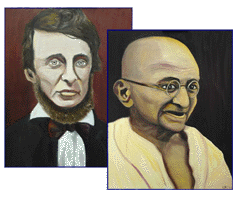"The whole aim of practical politics is to keep the populace alarmed (and hence clamorous to be led to safety) by menacing it with an endless series of hobgoblins, all of them imaginary." ~ H.L. Mencken
Goodbye to Tiny Town
The things that will destroy us are: politics without principle; pleasure without conscience; wealth without work; knowledge without character; business without morality; science without humanity, and worship without sacrifice. ~ Gandhi
Driving down the Parkway yesterday I saw what our greed, our pride, our arrogance, and our overwhelming self-centeredness has done to us and the world we live in.
Taylor 's Tiny Town is no more.
I feel lucky that I live in the same area in which I was born and where I grew up. My roots here run rather deep. At almost every turn I can remember who used to live here, what used to be there. And for my whole life, there have been very few constants on this part of the Parkway. My favorite by far was Taylor 's Tiny Town .
How it held out for so long is a mystery to me. After all, it was just an 18-hole miniature golf course. The price varied over the years, but it never cost very much to play. You got a ball and a putter, a little pencil and a Taylor 's Tiny Town scorecard. I can't tell you how many times my friends and I went there during high school ' with buddies, with dates, with groups of friends, even with parents.
Over the past 30 years, the Parkway has seen massive changes. They took out the old drive-in about ten years ago and built an outdoor mall there featuring a Wal-Mart and a Sam's Club. Its success made more such malls possible in that part of town. Now there's Starbucks and Montana Bread and Outback Steakhouse and Men's Wearhouse and other national chains. But smack dab in the middle of that burgeoning retail development ' a car dealership on one side, a bank and an Arby's on the other ' sat Taylor's Tiny Town, asking a mere dollar or two from everyone who wanted to play: a poor but proud and defiant individual amidst this gathering crowd of rich, soulless corporations.
We worried a couple of years ago when the old sign came down and the little building where the single employee handed out the putters and balls was torn down ' but it was only for renovations. The owner put up a new sign and a new, bigger building ' he started selling ice cream and custard and added a small grill for burgers and hot dogs. Tiny Town lived! And we celebrated by playing a couple of games. We didn't know those would be the last we'd ever play there.
The car dealership had been after that land for years. Tiny Town owned valuable Parkway frontage, something the dealership had relatively little of. Most of their cars were displayed behind their building, but if they could just get Tiny Town , they could make their ware much more prominent to those potential customers whizzing by on the Parkway ' in particular all those rich people waiting every day to turn left at the light into one of the most exclusive parts of town. Perhaps the owner, after all these years, had just had enough and decided to retire. Perhaps the price they offered was finally, after all these years, the right price. Either way, the car dealership got what it wanted.
Now, if that were all to the story, I wouldn't need to share it with you. Business owners retire or sell out every day. But it's what now fills that former parking lot that fills me with dismay and compels me to think and to write: 
Taylor 's Tiny Town is now full of SUVs: a solid metal-gray row of identical, aggressive, authoritarian, massive, militaristic SUVs, all of which had stiff little American flags attached to their radio antennae. I felt like I'd be sent to Guantanamo as a suspected terrorist if I didn't salute as I passed by ' SUVs: what Keith Bradsher in his book High and Mighty calls 'the world's most dangerous vehicles,' all of them flying the flag of the world's most dangerous government and standing, almost smirking, arrogantly and defiantly where once we parked to play innocent games of miniature golf when we were ourselves innocent.
The SUV, of course, is the vehicle that has saved Detroit ' at least for the time being. Its profits are staggering. After all, an SUV is simply a pickup truck with a fancier body placed on top. The profit on one Ford Expedition, according to Bradsher, is $12,000 (p. 84); the profit on one Lincoln Navigator is $15,000 (p. 85). The annual production of a single factory, the Michigan Truck Plant, 'was worth almost $11 billion ' greater than the global sales in 1998 for Fortune 500 companies like Northwest Airlines, CBS, Texas Instruments, Honeywell and Nike, and nearly equal to the sales of McDonalds, Abbott Laboratories or Lufthansa' (p. 88). That one factory, which made over a thousand full-size SUVs every day, 'accounted for a third of the company's entire profits' (p. 89). And yes, money can be very good: Bradsher says that ' Detroit automakers achieved wealth in the 1990s on a scale not seen since the 1960s. Their stock prices soared, executives pocketed multimillion-dollar bonuses and workers earned six-digit paychecks from the abundant overtime . . . . The arts flourished . . . . The inner city of Detroit began to revive, unemployment nearly disappeared and crime rates tumbled. This flush of prosperity was built to a great extent on SUV profits . . . .' (p. 82).
These profits come, of course, because people want SUVs and are willing, even eager, to pay the prices that generate such profits. Annual sales of these vehicles rose from 708,000 in 1990 to 3,501,000 in 2001 (p. 240). Owners say they buy them because SUVs have room for their families; because they are safe, secure, and comfortable; because they provide a better view of the road and the traffic ahead. They buy them they say, for intelligent, rational reasons.
Marketing experts, however, believe differently. Marketers believe that people make their buying decisions emotionally, rationalizing them afterwards, and they design their marketing efforts with that in mind. And according to the auto industry's market researchers and executives, the average SUV buyers tend to be insecure and vain Baby Boomers, nervous about marriage, uncomfortable with parenthood, and lacking confidence in their driving skills. They are likely to be self-centered and self-absorbed and have little interest in their neighbors or communities (p. 101).
Now it's important ' it's essential ' not to misunderstand this material. This is not what some people feel; this is the result of expensive, intensive market research. Auto companies can't afford to operate on a wing and a prayer. They need to know as much about their potential customer as they can in order to give that customer what he wants ' or, conversely, that the customer wants what the company has to give. They can't just make this up. Too much money is riding on it. As Bradsher says, 'Each of these detailed surveys are filled out by 35,000 to 115,000 people who have bought new vehicles in the last several months. These surveys, backed up by many interviews with consumers in focus groups, dwarf anything done by politicians and journalists' (p. 101-2). And that's what makes this information worth serious consideration.
According to this research, SUV buyers are very concerned with how others see them; several people quoted in the book say that the SUV is primarily an image vehicle. 'It's an image vehicle,' said the former design director for Ford SUVs. 'It says something about your lifestyle' (p. 103). They also want control. A top engineer with GM said 'SUV owners want to be more like, 'I'm in control of the people around me'' (p. 104). A Ford strategist said that 'It's about not letting anything get in your way and, at the extreme, about intimidating others to get out of your way.' SUV buyers, say these surveys, tend to be more restless, more sybaritic and less social than most Americans ' they're less giving and less oriented to others (p. 106).
Most frighteningly, though, is the research indicating that 'the self-centered lifestyle of SUV buyers comes through in their approach to traffic safety, especially their willingness to endanger other motorists so as to achieve small improvements in their personal safety' (p. 107). While SUVs are apparently somewhat safer for the occupants, they are much more dangerous to others, much more likely to kill people in the other vehicles because of their height, size, and weight. The full-size Chevrolet Blazer, now called the Tahoe, had a kill rate of 122 people per million Blazers compared to 21 deaths per million Honda Accords and 38 per million Ford Tauruses (p. 180). However, auto makers say that 'their market research shows that few vehicle buyers specifically consider the safety of other motorists in deciding what model to buy' (p. 205). Bradsher estimates that SUVs cause close to 3,000 needless deaths every year: 1,000 from rollovers (due to their weight and height), 1,000 from cars hit by SUVs who would have lived if they'd been hit by regular cars (an SUV is officially a light truck), and 1,000 from the respiratory problems caused by the extra smog they cause (p. xvii-xviii). And, finally, while minivans, which get better gas mileage, produce less pollution, and are much less dangerous to other motorists, are certainly an option for those with families, SUV buyers almost never consider them. As Bradsher says, 'rising sales of SUVs represent a triumph of image and marketing over practicality' (p. 109). Minivans are for 'soccer moms.' According to the general manager of Chrysler's minivan operations, 'we could sell twice as many minivans'if it were not for the image thing' (p. 109).
It used to be that, when I drove or rode my bicycle down the Parkway, I'd look at Taylor's Tiny Town and see the past: small town America, kindness, mutual respect, the power of the individual entrepreneur. I saw family and fun, freedom and happiness. But that's gone now ' gone forever ' replaced by Power, by force and greed and arrogance and selfishness: the same qualities, the same characteristics, that have sent the American military, those efficient, highly trained, and well-equipped government-financed mass murderers, into Afghanistan and Iraq and perhaps soon into Iran to kill for us so that we might have the Power we so crave, the Power we're so desperate to have ' the Power we're terminally addicted to. I see what this country, and what we as people, have become: a straight, military line of identical machines bearing stiff, inflexible, identical flags. It's so easy, so American, to accuse the government and decry war while at the same time reveling thousands of miles away in its spoils. We want control over others, whether it's on the Parkway or in the Persian Gulf. Can we honestly blame the government? Wasn't Shakespeare right when he wrote, 'The fault, dear Brutus, is not in our stars but in ourselves . . . .'?
Goodbye, Tiny Town. I'm sorry I didn't play more. And I'll miss you more than I can say.








 Reprint Rights
Reprint Rights